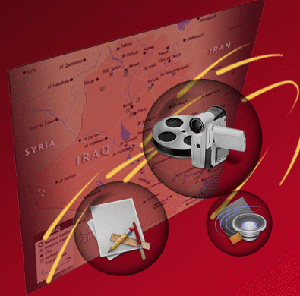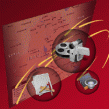Islamist Websites Succeed in Recruiting Muslims for Jihad
Publication: Terrorism Focus Volume: 3 Issue: 46
By:

Jihadi leaders continue to establish new websites on the internet by which they spread their ideology and identify users who can be recruited for the global jihad. If preaching and disseminating fanatical and extreme ideas on the internet is itself a concern, the use of jihadi forums to entice potential terrorists is even more threatening and must be addressed before the young and pious are lured into extremism. There are thousands of jihadi websites, and each time one is shutdown it often reappears under a different URL.
It only takes a quick glance at a handful of these websites to realize how effective and appealing they are to young Muslim men and women who seek to practice correct Islamic ideology and who wish to rid the Muslim world of “infidel colonizers.” One of the latest websites that jihadis have launched is called al-Boraq Media (https://www.alboraqmedia.org). The site contains up-to-date information about the jihad in Iraq and Afghanistan, in addition to other theaters of operations. The most effective media materials are the video clips of shootings, explosions and the destruction of U.S. military vehicles; these videos are uploaded to their websites in different sizes and qualities. Also, because jihadis are not content with television channels like al-Jazeera—since the networks often edit and omit parts of speeches delivered by Osama bin Laden, Ayman al-Zawahiri and other lower-ranking al-Qaeda leaders—they upload the full speeches and lectures to their websites. The video clips mostly fall under four categories:
– Training: explanation of how to make bombs and explosive substances;
– Operations: ambushes, bombings and the killing of “enemy” forces;
– Speeches: full speeches of jihadi leaders and Salafi ideologues;
– Photography: pictures of civilians killed and injured by enemy bombs.
Currently, the most effective jihadi propaganda videos are the two clips of Baghdad’s sniper, nicknamed “Juba” by the U.S. military. “The Baghdad Sniper” was produced by the al-Fajr Media Center for the Islamic Army in Iraq and was posted on many jihadi websites. The videos show different sniper attacks on U.S. soldiers patrolling the streets of Iraq. The video clips are well produced with fervent Islamic chanting songs in the background and translated comments made by U.S. officers about the Baghdad sniper that appeared in the Western media. These videos also demonstrate the vulnerabilities of U.S. soldiers, attracting more aspiring mujahideen to the jihad since they show that defeating U.S. forces is possible.
Why do jihadis spend so much time and effort on their media operations? The requisites of jihad and field operations are correlated to the jihadi media objectives in the sense that jihadis need money and manpower to sustain terrorist operations. Therefore, the jihadis chat with sympathizers of the jihad on Islamist forums, show them video clips of successful operations against the “occupiers” and provide religious lectures on the virtues of either participating in jihad or donating money to the mujahideen. Many discussions result in willing recruits posting their e-mail addresses and imploring actual jihadi operators to contact them and guide them toward the path of jihad. The following quote, for example, is from a user with the alias of Abu al-Qassim al-Yemeni who wrote from Yemen. His statement on the forum illustrates the eagerness of many to participate in jihad: “I am a young man from Yemen thirsty for jihad. May Allah place you in the land of jihad and resistance and I hope to be along your side. I also look forward for your letters in my e-mail box.” Some websites have more than 14 pages of such requests. The aspiring mujahideen are from many countries, Arab and non-Arab. In some cases, the requests to take part in jihad are straightforward, where the forum user asks to go to a specific country for jihad (https://www.watein.com, September 10). The most popular destinations for jihad appear to be Iraq, Afghanistan and Palestine.
In addition, jihadi websites that post explosive and other military training techniques have links encouraging the willing to join their jihadi cells to fight the “creeping crusaders.” Other users declare the establishment of new jihadi cells and post their e-mail addresses to solicit funds for their operations. Such was the case with a cell called Saraya al-Tawhed (Detachments of Monotheism) (https://alsayf.com, August 16). The directions on how to transfer funds are not provided until contact is initiated and after a vetting procedure takes place. Also, jihadis encourage the use of different internet chat utilities such as Yahoo Messenger since it is more difficult to monitor these methods of communication when compared to e-mail transmissions (https://moqaawama.jeeran.com).
The mujahideen phenomenon can be divided into three categories. The majority are “sympathizers,” who are influenced by the websites into supporting bin Laden, al-Zawahiri and other jihadi leaders in their calls to implement Islamic Sharia and to fight the enemies of the ummah; these sympathizers do not take tangible action to further the cause. The minority of the jihadis are staunch adherents to the Islamic holy war doctrine. The third type of jihadis are those who have been successfully radicalized and are willing to travel to jihadi battle fronts. The success of these willing recruits in reaching jihadi theaters of conflict and participating in violent activities is obvious judging from the replies they receive to their requests from jihadi website owners and moderators. Until action is taken to prevent sympathizers from actively participating in the jihad, the internet will remain a useful recruiting tool for jihadi leaders.




